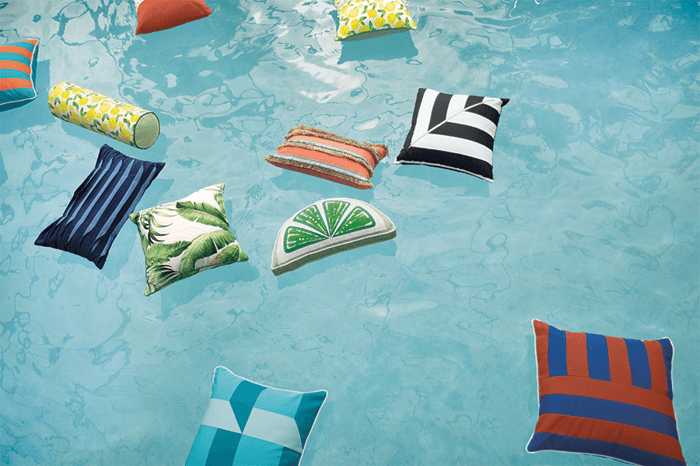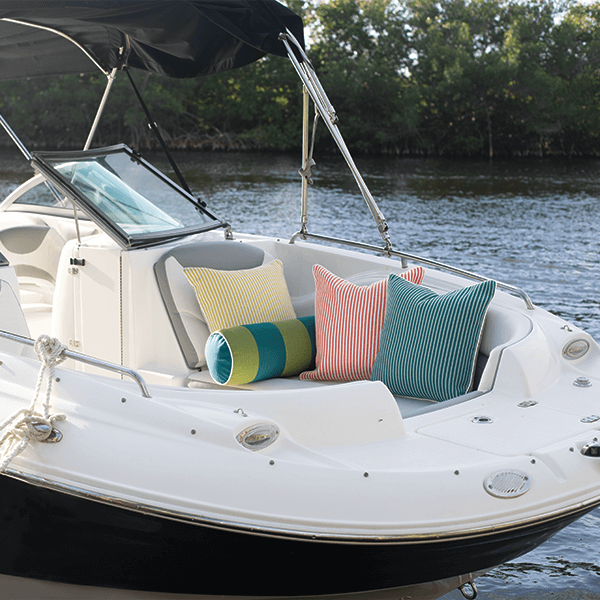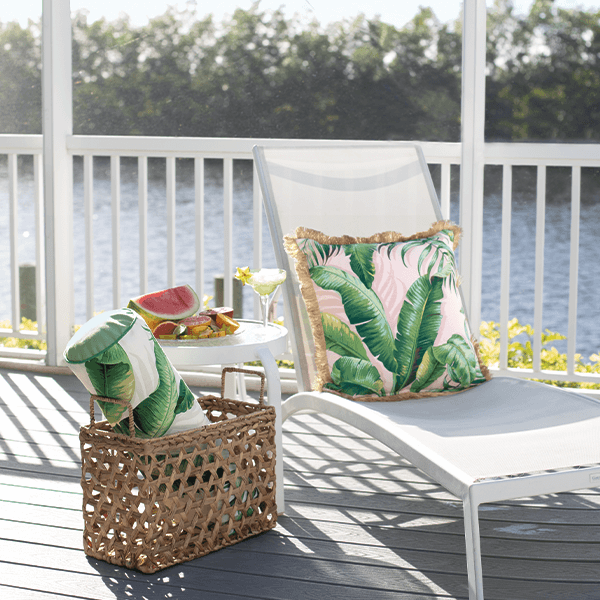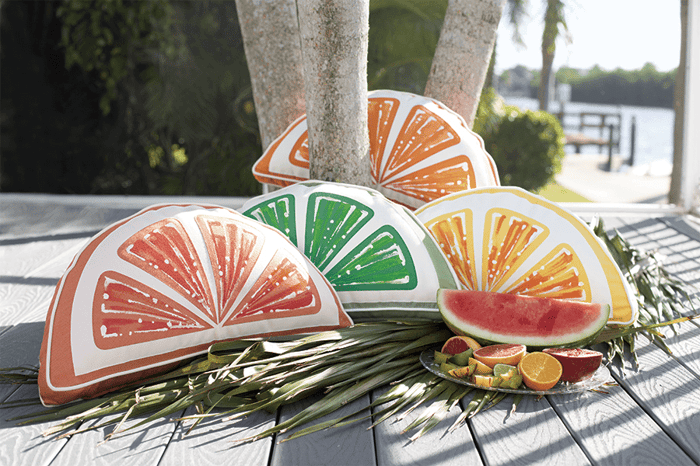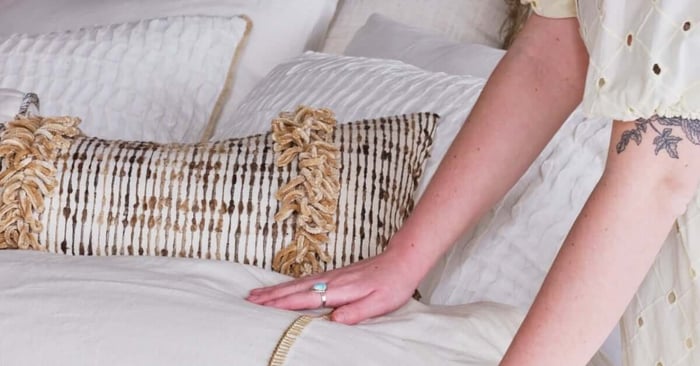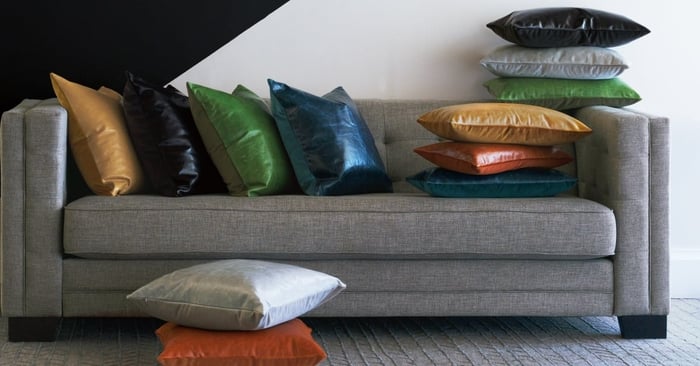Table of Contents
Outdoor living calls for materials that can do more than just look good. Fabrics need to withstand bright sun, summer storms, and the wear and tear of daily use, all without losing their shape, color, or comfort. That’s where the construction and composition of outdoor textiles come into play. From the science behind UV resistance to the careful selection of yarns and finishes, understanding how fabrics for outdoor pillows are built helps explain why they perform the way they do, and why they feel so different from their indoor counterparts.
What Makes Outdoor Fabrics Different?
Outdoor fabrics are designed with durability in mind. While indoor textiles tend to prioritize softness, drape, or luxury textures, outdoor fabrics have to balance form and function, performing well under the sun, rain, and everyday use.
A few key differences:
- Lightfastness: Outdoor fabrics are made to resist fading and breakdown from prolonged sun exposure. This is often referred to as UV resistance or colorfastness.
- Water resistance: Many outdoor fabrics repel moisture or dry quickly to prevent mold and mildew.
- Ease of care: Most can be easily wiped down or spot cleaned, making them practical for high-traffic areas or changing weather.
These performance qualities are what allow outdoor pillows to last through several seasons without looking worn out or damaged.
Sun Resistance: Built into the Fiber
Outdoor pillows hold up to sun exposure largely because of the fibers used to make the fabric. Both solution-dyed acrylic and polypropylene are known for their excellent lightfastness. Since the color is integrated during the fiber formation process, it doesn’t wash out or fade as quickly as surface-dyed fabrics. This makes a big difference for any item that will spend extended time outside.
How Weather Resistance Works
There’s no single formula for making a fabric “outdoor-safe,” but there are a few main categories of materials and finishes that are commonly used. Each has its strengths and characteristics:
Solution-Dyed Acrylic
With this method, color is added to the liquid acrylic before the fibers are even formed. Because the pigment runs through the entire fiber (rather than sitting on the surface), it’s highly resistant to fading, even after long sun exposure. Acrylic also naturally resists moisture and mildew, making it one of the most common choices for outdoor fabrics.
Polypropylene (Olefin)
This synthetic yarn is lightweight and durable. It resists moisture, mold, and most chemicals, and holds up well to abrasion. Polypropylene fabrics are often used for outdoor rugs as well as pillows, and they offer more texture and variety than many standard outdoor fabrics. They also tend to be more budget-friendly than some other synthetics, which is part of what makes them widely used.
Coatings and Finishes
Sometimes, outdoor yarns are treated with an additional layer of protection, like polyurethane (PU), silicone, Teflon, or PVC. These coatings can improve water resistance or add strength, depending on the application. Not all outdoor fabrics use them, but they can offer another level of performance in tougher conditions.
Choosing Fabrics for Outdoor Use
The process of selecting fabrics for outdoor pillows is thoughtful and collaborative. It begins with performance, making sure the material can handle outdoor conditions reliably, and continues with design. Just like with our indoor collections, we look for variety:
Rich solid colors that come in a variety of colors
Fun prints, motifs, or patterns
Interesting textures
We work with mills we’ve come to trust for quality and consistency, especially when it comes to lead times and color runs. While the goal is always to find fabrics that perform well, we also look for those that bring something unique, whether it’s a soft, indoor-like texture or a print that adds energy to a neutral outdoor palette.
Outdoor pillows are more than just functional—they’re an opportunity to bring your design point of view outside. Whether you’re styling a breezy coastal deck or a moody modern balcony, the fabrics you choose help set the tone and tell the story of the space. With performance features like UV resistance, water repellency, and easy care, outdoor textiles can stand up to the demands of open-air living, without compromising on style.
Choosing the right materials, textures, and colors ensures your outdoor space feels just as intentional and inviting as the rooms inside. After all, good design doesn’t stop at the back door.
FAQs
What are outdoor fabrics?
Outdoor (or indoor/outdoor) fabrics are textiles that are designed to better withstand damage from spending long periods outside. Outdoor-friendly fabrics are usually lightfast, water-resistant, and easy to care for. This means that they do not fade or break down easily in the sun and can tolerate some water exposure without damage, molding, or mildewing. They can also be easily wiped down or spot-cleaned.
Are outdoor pillows waterproof?
No, outdoor pillows are not fully waterproof. They are typically water-resistant, which means they can withstand a reasonable amount of water damage, but water exposure should still be avoided when possible. For example, we recommend covering or bringing your outdoor textiles indoors before forecasted rain.
What makes a fabric weather-resistant?
There’s no single formula for making a fabric “outdoor-safe,” but there are a few main categories of materials and finishes that are commonly used. Each has its strengths and characteristics:
- Solution-dyed acrylic. With this method, color is added to the liquid acrylic before the fibers are even formed. Because the pigment runs through the entire fiber (rather than sitting on the surface), it’s highly resistant to fading, even after long sun exposure. Acrylic also naturally resists moisture and mildew, making it one of the most common choices for outdoor fabrics.
- Olefin. This synthetic yarn is lightweight and durable. It resists moisture, mold, and most chemicals, and holds up well to abrasion. Polypropylene or Olefin fabrics are often used for outdoor rugs as well as pillows, and they offer more texture and variety than many standard outdoor fabrics.
- Coatings and finishes. Sometimes, outdoor yarns are treated with an additional layer of protection, like polyurethane (PU), silicone, Teflon, or PVC. These coatings can improve water resistance or add strength, depending on the application.
Do outdoor fabrics feel different from regular ones?
Not always. While these advanced synthetic fibers will never have the same texture as organic linen, cotton, or leather, there have been great advances in outdoor textiles in recent years. While older varieties might have had a distinctive "plastic coating" feeling, today's premium outdoor fabrics have a much more natural feel and often do not feel different from indoor-only textiles.


